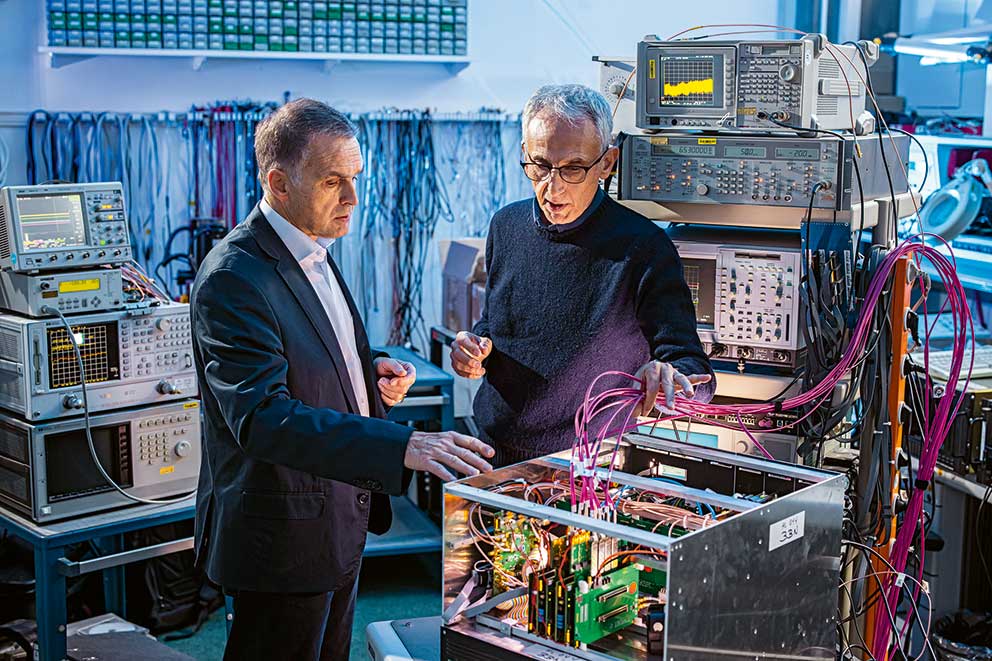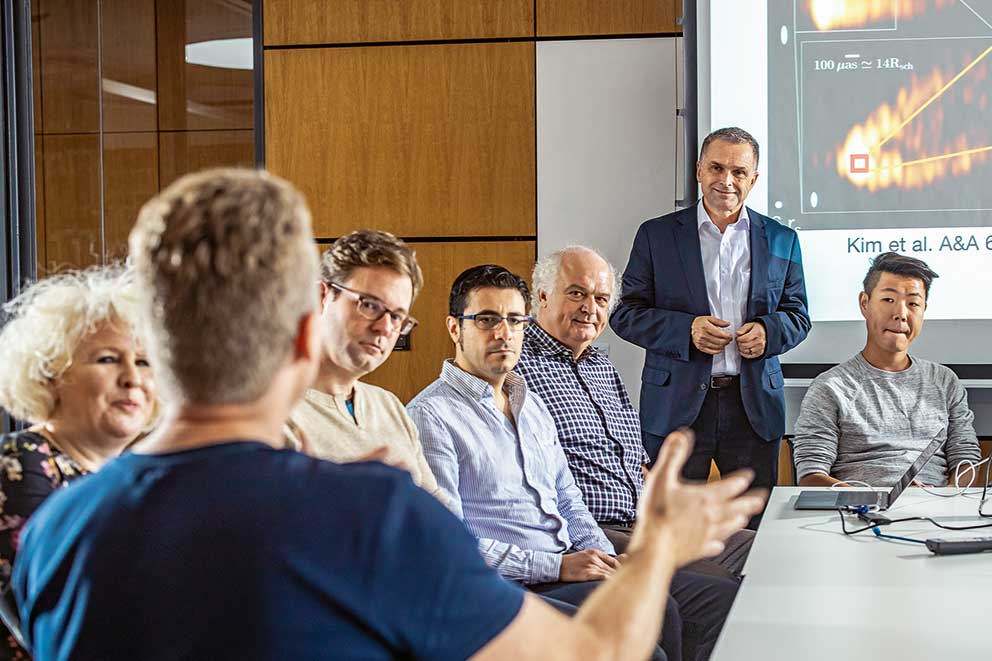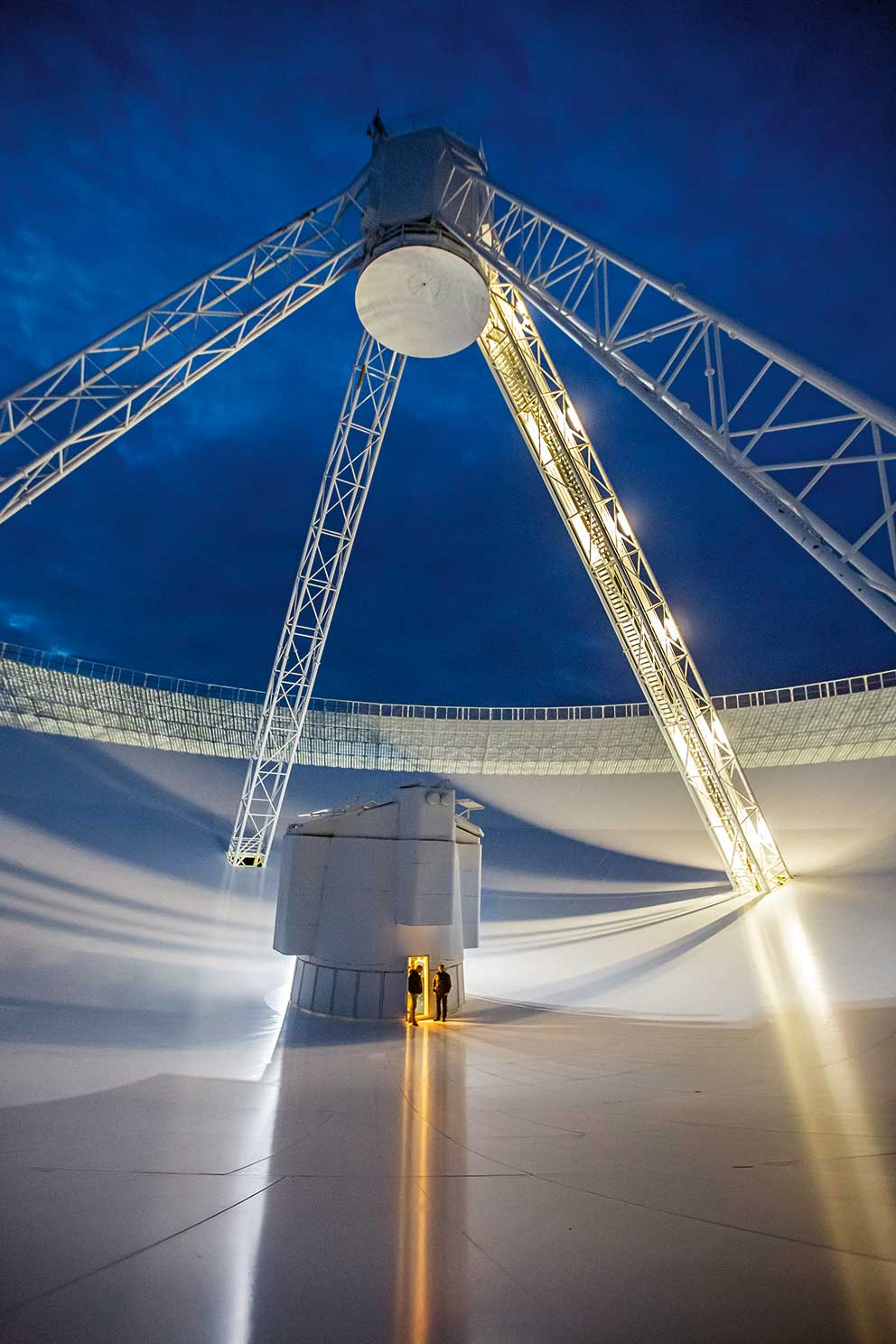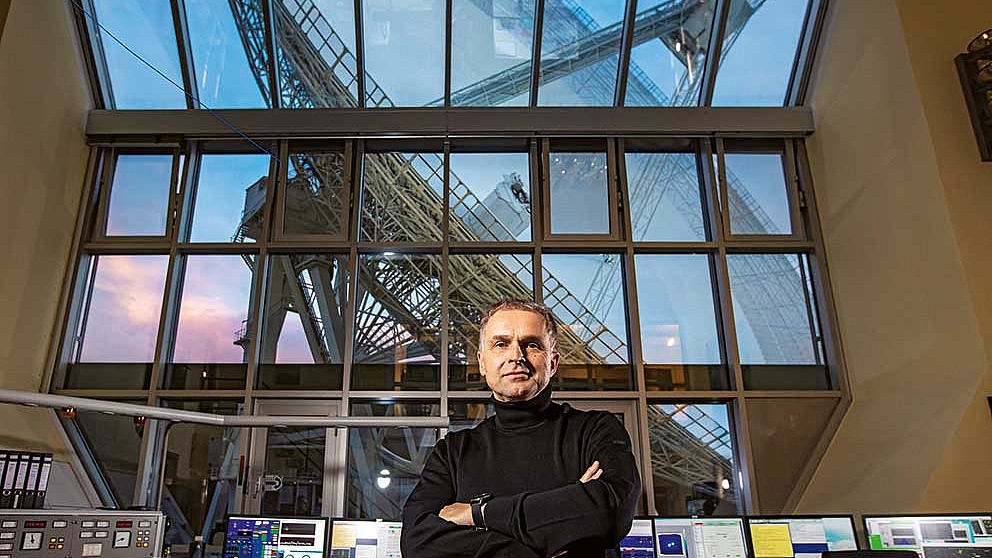Jump to the content
- {{#headlines}}
- {{title}} {{/headlines}}

Radioastronomer Professor Dr Anton Zensus, the Director of the Max Planck Institute for Radio Astronomy in Bonn, was granted the Humboldt Research Award in 1994 and the Max Planck Research Award in 1999. Anton Zensus read physics and astronomy in Cologne and Münster where he completed his doctorate in 1984. In 1985, he relocated to the United States as a postdoc at California Institute of Technology in Pasadena, California, moving to the National Radio Astronomy Observatory in Socorro, New Mexico, and Charlottesville, Virginia, in 1988. Anton Zensus became a scientific member of the Max Planck Society in 1996 and was appointed director of the Bonn institute where he heads the Very Long Baseline Interferometry (VLBI) research department.
Even for a sober physicist, black holes are a fascinating phenomenon because they are, literally, attractive: due to their enormous gravitational force, matter is unable to escape their vicinities. Even light and other electromagnetic waves fail to get away, which is precisely why they are “black”. The theoretical concept of black holes had been haunting the universe for more than a century, as they were believed to be a consequence of the General Theory of Relativity. But although the physicist Karl Schwarzschild derived them from Einstein’s equations back in 1916, Einstein himself doubted their existence. While there is very little doubt amongst astrophysicists today that the cosmos is full of such bizarre objects, until spring last year they had only indirect evidence.
But despite this, it had to be possible to visually prove the existence of black holes – this had been Anton Zensus’ creed for much of his scientific career. He had discovered his interest in space while studying physics in Münster – and it never left him. But it was only perseverance and unrelenting work on scientific and technical innovations that finally led to success.

It is not easy to meet Anton Zensus in autumn 2019. If you want to interview the astrophysicist, you first have to manage to make an appointment with him. Whether he is giving lectures, appearing before a fascinated lay audience or attending award ceremonies: Zensus is in demand. But then it works out, after all – at his own place of work, the Max Planck Institute for Radio Astronomy in Bonn, of which he is the director. On top of this, he heads a consortium of some 200 researchers from 60 institutes – the Event Horizon Telescope (EHT) Collaboration Council. Why is there such huge interest in this radio astronomer? Just six months ago, on 10 April 2019, the EHT team announced an extraordinary breakthrough: after decades of preparation, experts had managed to do what had been considered impossible: to capture an image of a black hole.
Known to millions of cinemagoers in its fictitious form from the space epic, Interstellar, the mysterious object can now effectively be viewed in natura. The image was presented to the public around the world at simultaneous press conferences, one of which was in Brussels in the presence of the EU’s Commissioner for Science, Carlos Moedas. The Portuguese Commissioner’s words were indicative of the significance of the event. He spoke of “a huge breakthrough for humanity.” To date, a recording of the press conference has been viewed more than three million times online. And the image of the black hole triggered a flood of headlines in the world press. Since then, a poster with selected title stories has adorned the wall in Zensus’ office in Bonn. “We were surprised by this tsunami of public interest,” he admits. “Something like this can only happen to a scientist once in a lifetime.”
A fascinating scientific phenomenon
It was already well known that visible light is unsuitable for imaging black holes. Only shortwave radiation can travel the cosmic distances between the object of study and the observer on Earth unhindered. So, the required antennae first had to be prepared to receive the millimetre waves and computers had to learn to generate a photo-like image from the measurement data. Nor could the measurements themselves be taken by one single radio observatory. Only by linking eight individual telescopes in Chile, Mexico, Hawaii, Arizona, Spain and the Antarctic was it possible to create a sufficiently large virtual radio telescope with enough magnification to capture the relatively tiny black hole. In the technical jargon used by the experts, this is known as Very Long Baseline Inferrometry. In particular, the 66 ALMA antennae (Atacama Large Millimeter Array) in Chile that were integrated in the EHT network were a crucial success factor.
“Something like this can only happen to a scientist once in a lifetime.”
“International cooperation is indispensable for our research,” explains Zensus who has spent 16 years of his career in the United States – at Caltech, California, in New Mexico, and later in Charlottesville, Virginia. Here, at the headquarters of the National Radio Astronomy Observatory, he honed both the technical and organisational skills that were conducive to later becoming the head of the EHT Consortium, since the network of radio antennae had to have a solid organisational footing. Zensus: “In two years, we had about 50 meetings.” His task as chairman was to elaborate a detailed agreement balancing out the various interests to serve the common objective. Zensus: “That sometimes meant taking the lead.”

Now, everyone can picture what a black hole looks like. The one caught by the EHT researchers is in the Virgo Constellation, right in the middle of the enormous elliptical galaxy M87. In the club of black holes it is a particularly massive member, weighing in at 6.5 billion solar masses. The image shows a central area which is actually black. The actual hole is invisible to the eye, hidden in this dark zone and surrounded by a bright region. Zensus explains: “That is hot, radiating matter that has collected in a ring around the hole.” A considerable part of the shining matter was even behind the black hole. This is because such a massive object bends space and time so strongly that it deflects light. After a certain point, the beams of light then run circles around the object. So, to be precise, the image does not show the black hole itself, but its shadow and the immediate environment.
Cooperation across national borders
One of the reasons why black holes are so popular is because they have a mystical, threatening aura. The fictitious example in the film Interstellar is called Gargantua, like the father of all grotesque giants in the eponymous Renaissance story by Rabelais. Today, its genuine equivalent in galaxy M87 has also sparked the interest of people who are otherwise indifferent to physics and astronomy. “We are now perceived quite differently,” says Zensus. “I never used to be invited to give lectures to SMEs; now I am.” And young people are showing much more interest, too, which means a boost for scientific and technical subjects. Zensus: “Neither of my sons works in science. Now their friends ask them about the fascinating research their father and his colleagues are doing. That’s a new experience for me.”

There is also more official support for radio astronomy than there used to be. “And that is essential if we are going to retain our leading position in this research,” Zensus emphasises. The network needs additional radio telescopes to improve the quality of future images and help to interpret them scientifically. Radio antennae on satellites in space could also contribute to this, too.
“It questions the whole basis of modern physics.”
But research into black holes is not just about distant heavenly bodies. It questions the whole basis of modern physics. Due to their extreme gravitational fields, the General Theory of Relativity has to prove itself under conditions that were never previously considered. So far, Einstein’s thought edifice has withstood the stress test to which the EHT researchers have subjected it.
Currently, the consortium is working on capturing the black hole at the centre of our Milky Way. They already have the measurements and are busy evaluating them. Although it is 2,000 times nearer than the one in M87, it is no easier to catch the image. Zensus explains: “The relatively fast changes in the centre of the Milky Way cause disturbances and make it hard to take a photo. At the moment, we are trying to eliminate this effect.” Zensus takes a careful look at his watch: his next trip is about to start. He is flying to the award ceremony for the 2019 Breakthrough Prize in Fundamental Physics which has been awarded to the entire EHT team. Sometimes referred to as the “Physics Oscar”, it is presented at NASA’s Ames Center in California. And a few days later, he is off to the Falling Walls conference in Berlin where people want to hear more about the breakthrough with black holes. The wave of curiosity and fascination continues unabated.
published in Humboldt Kosmos 111/2020

